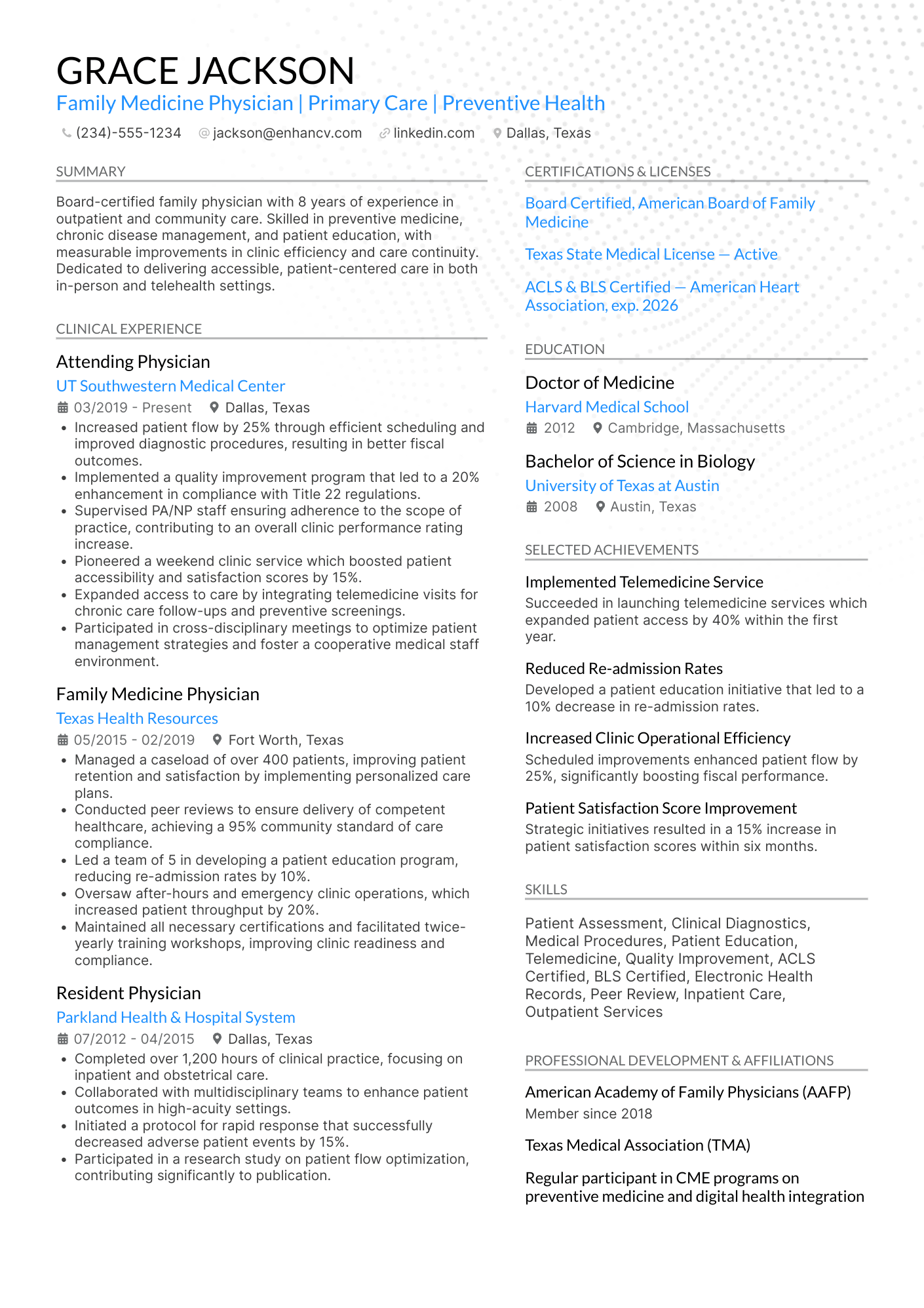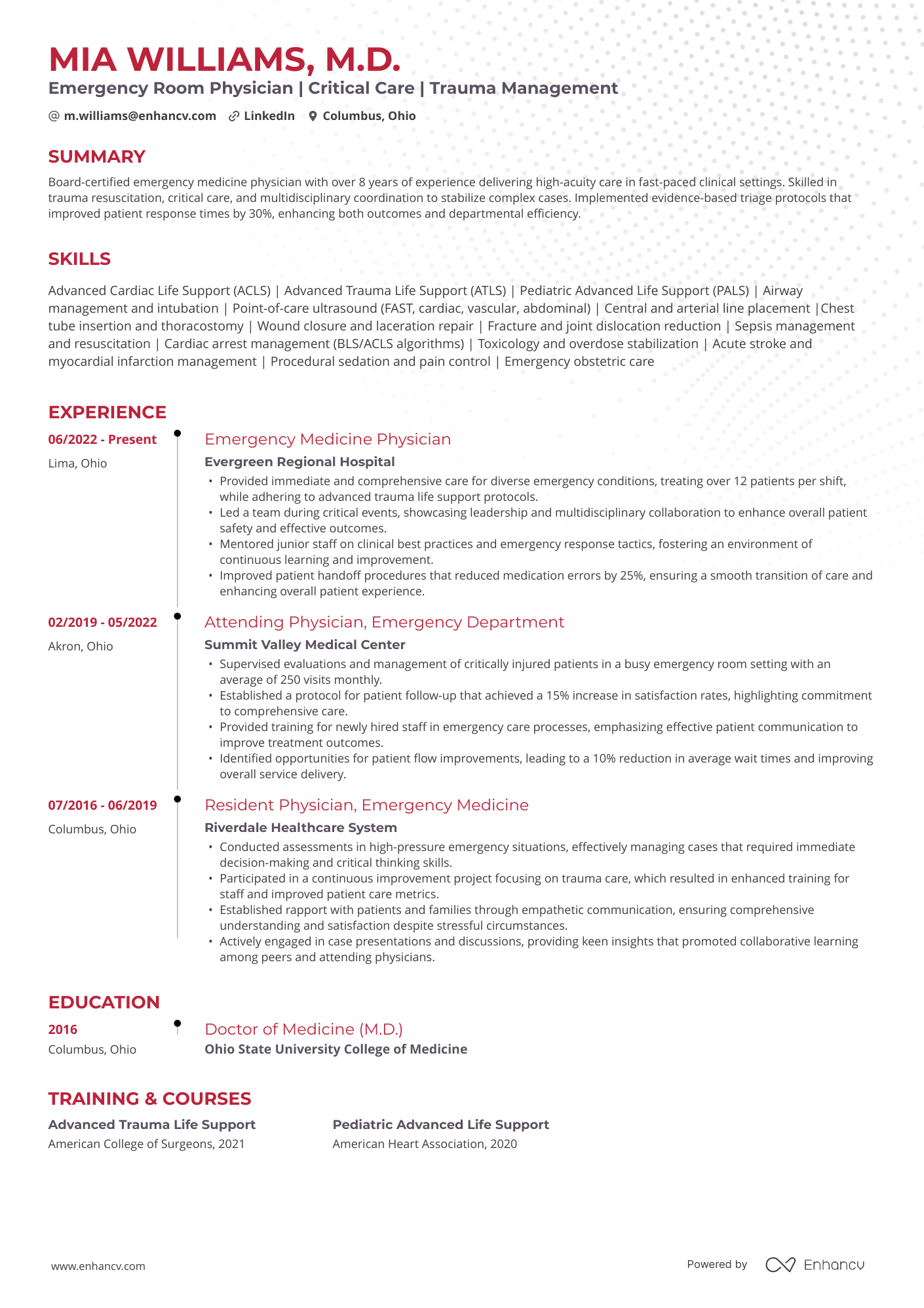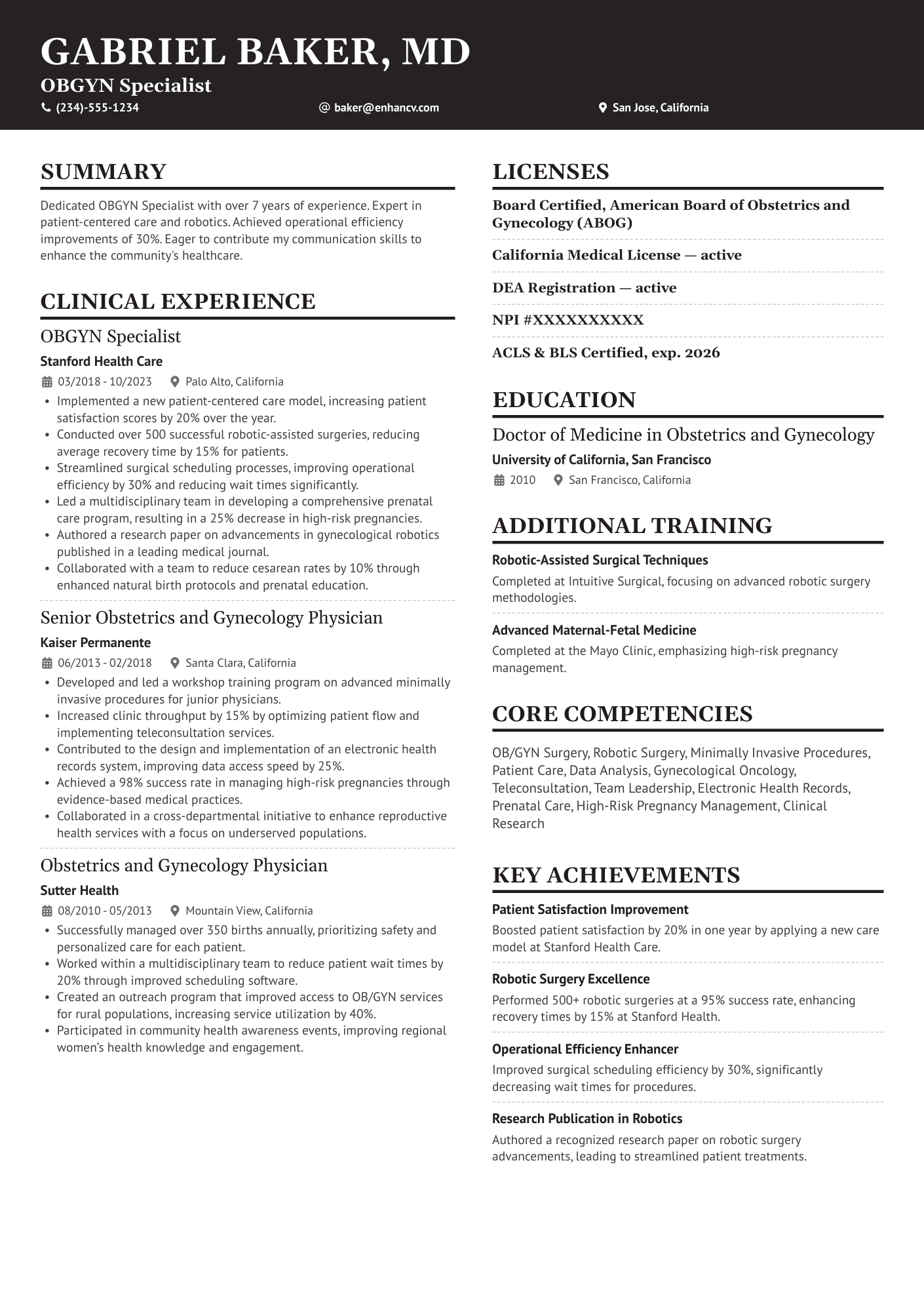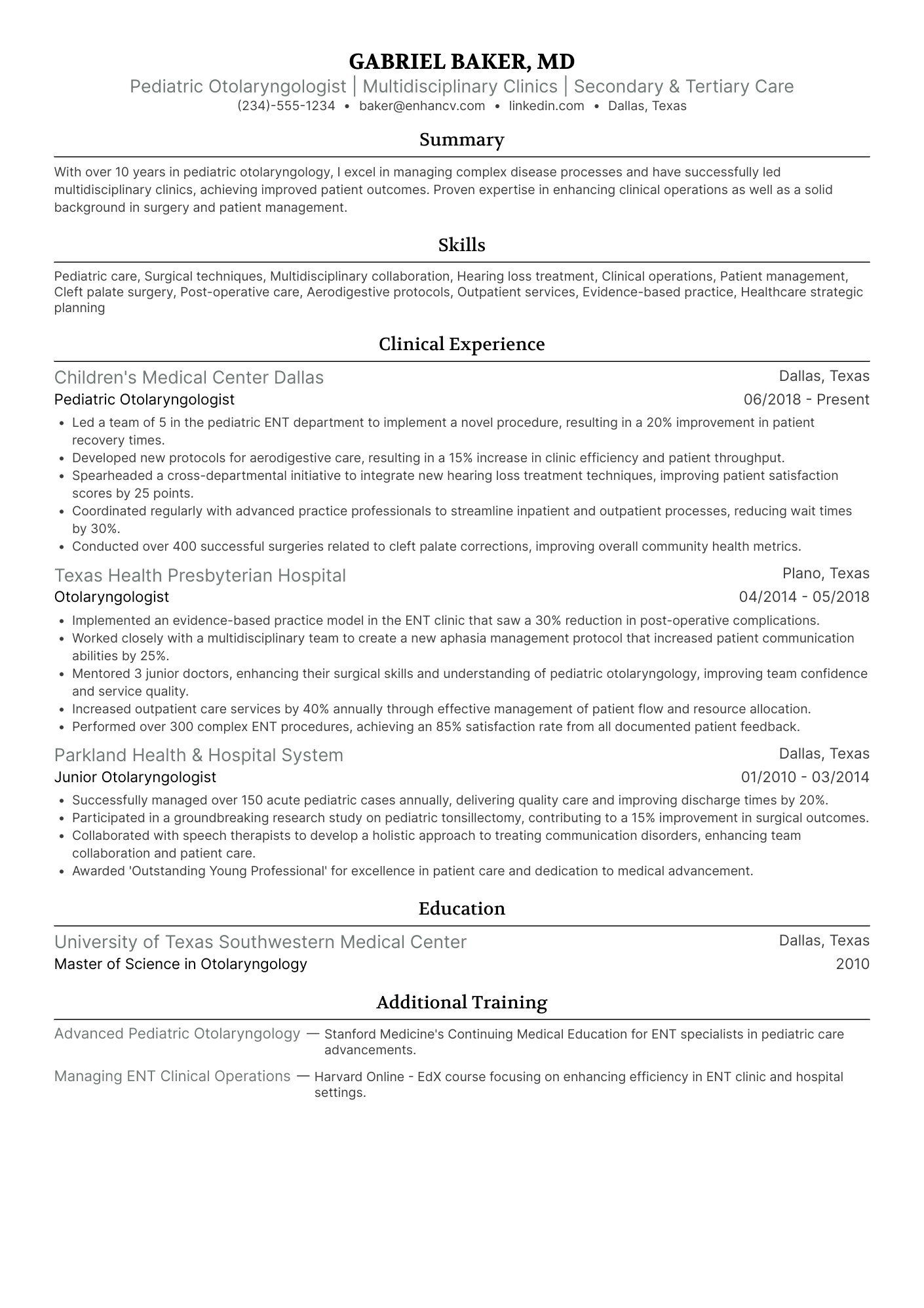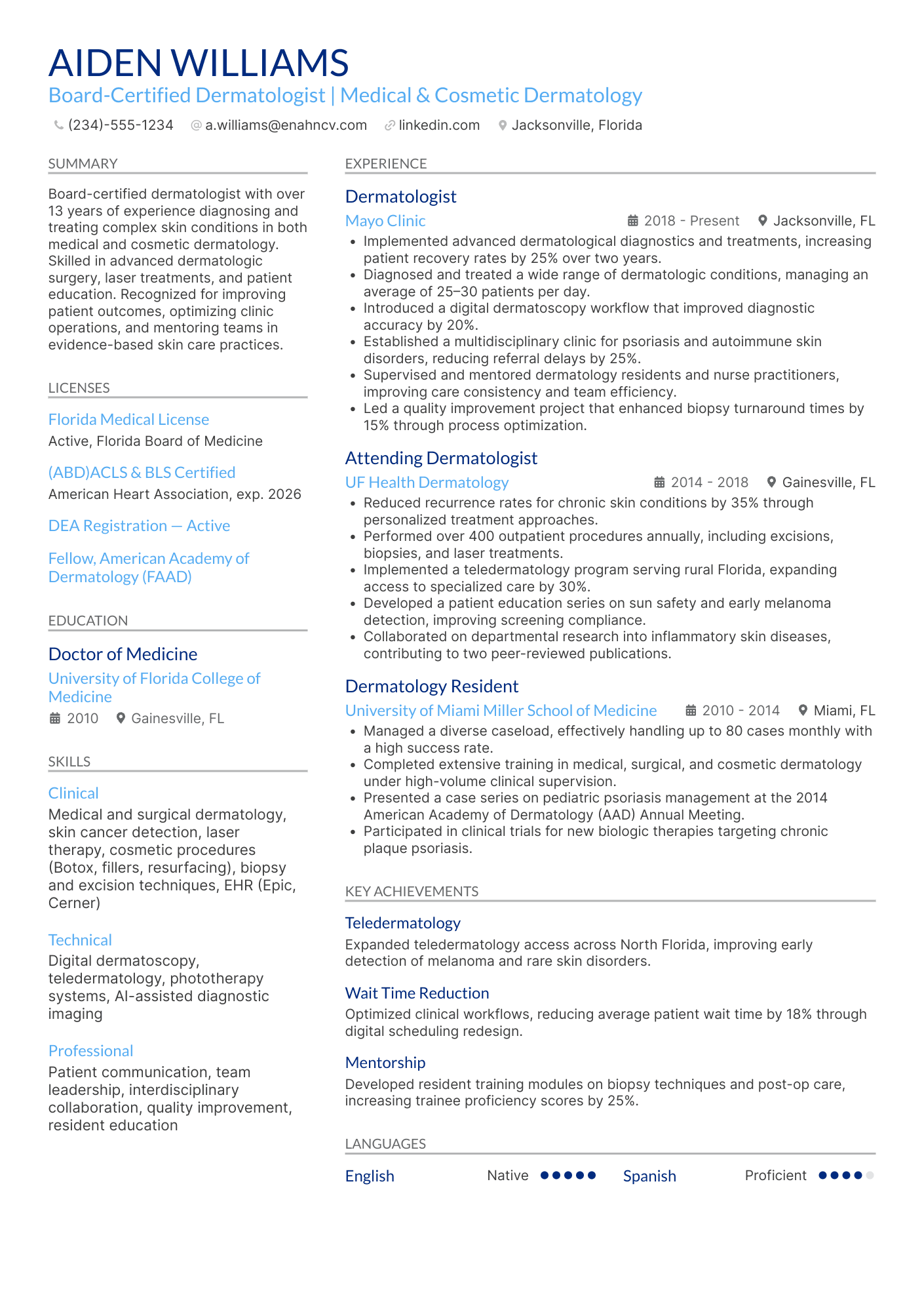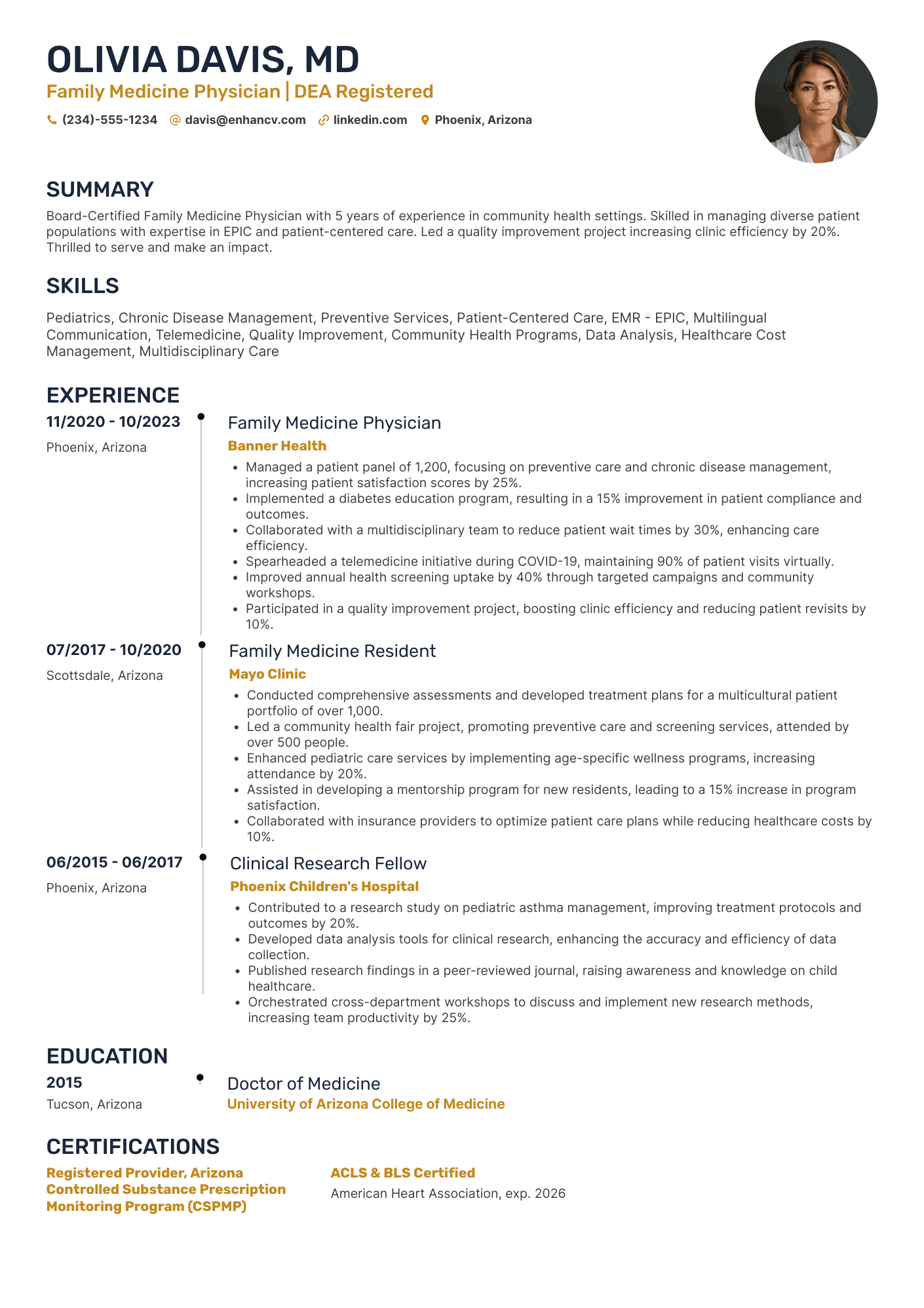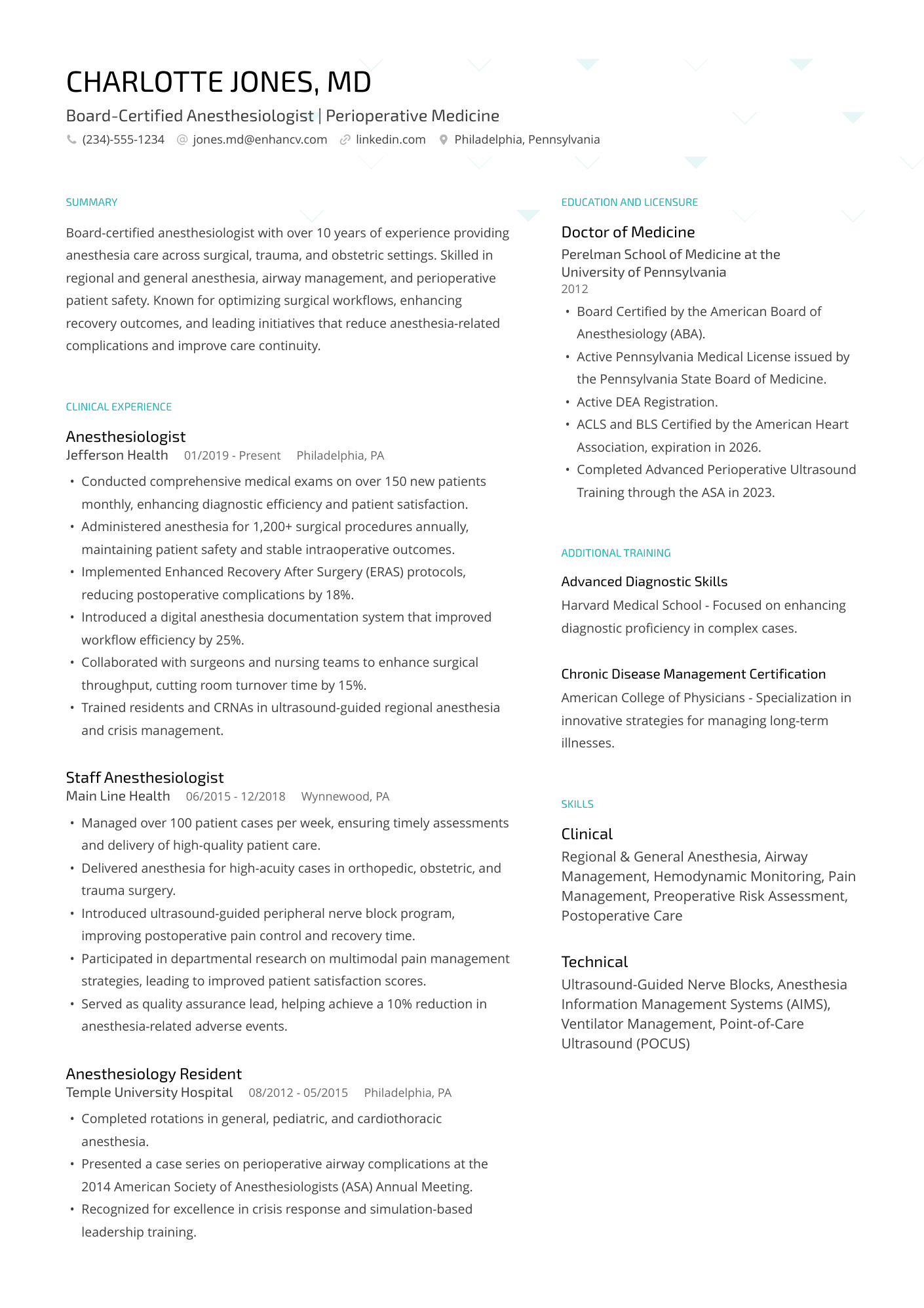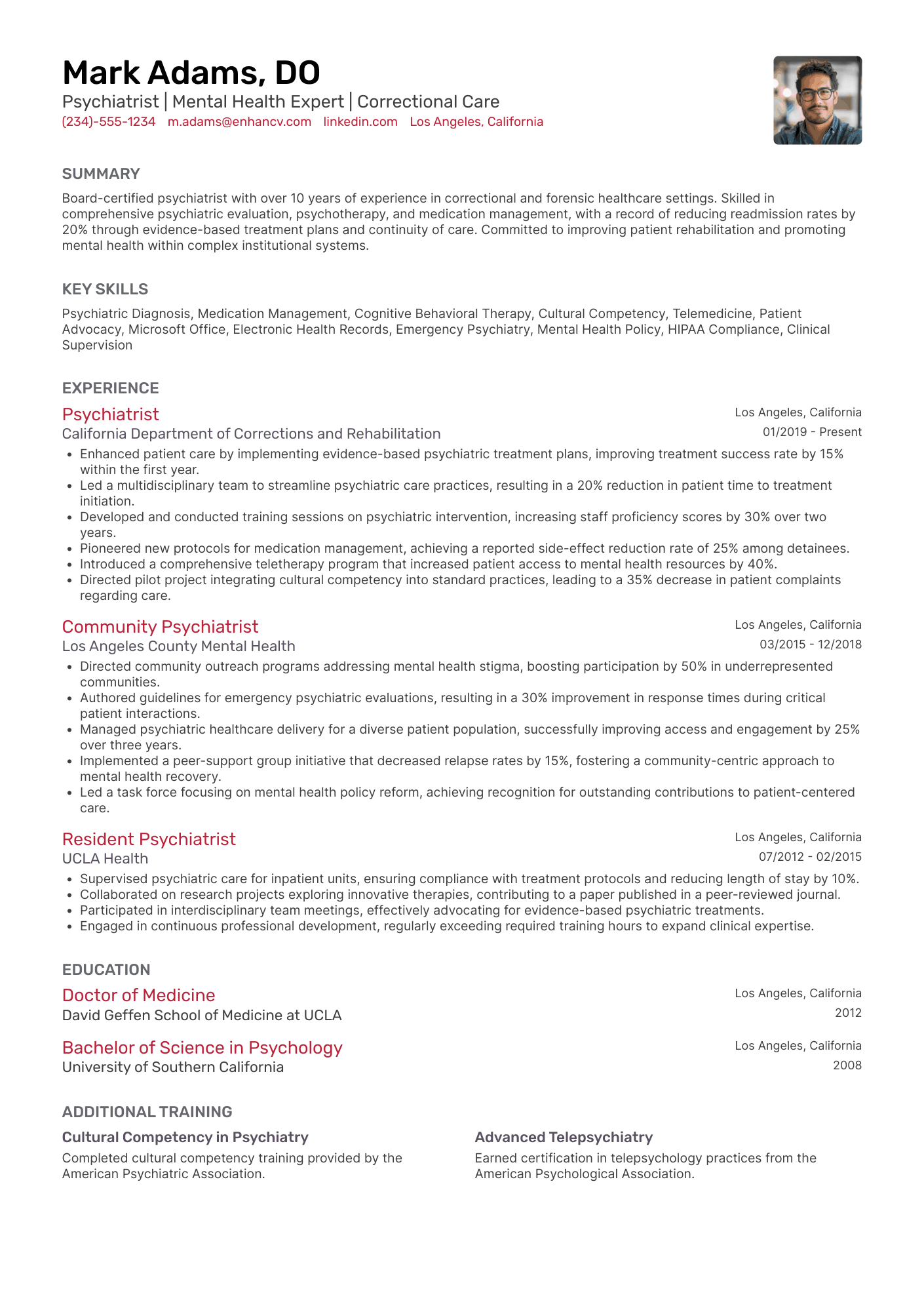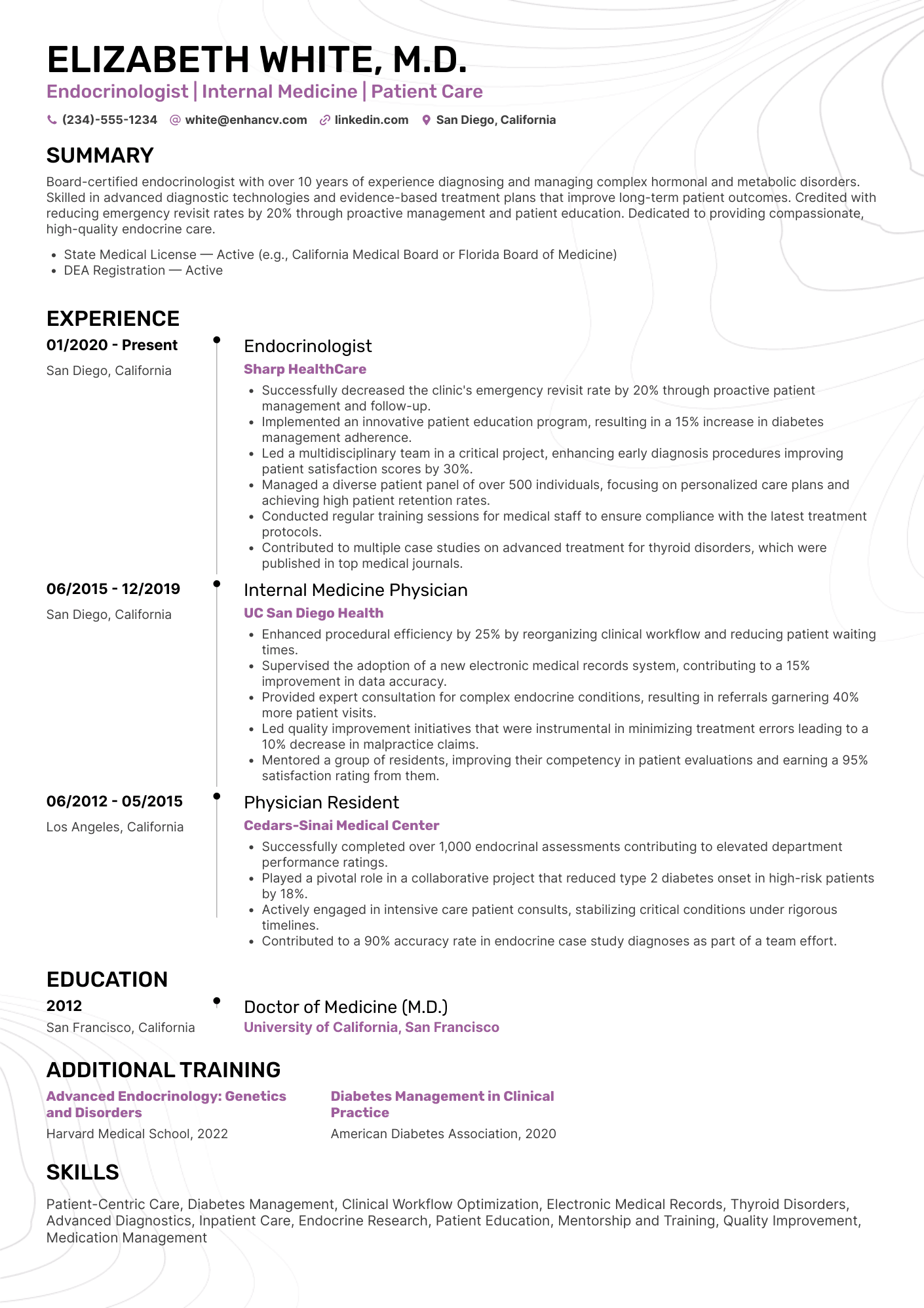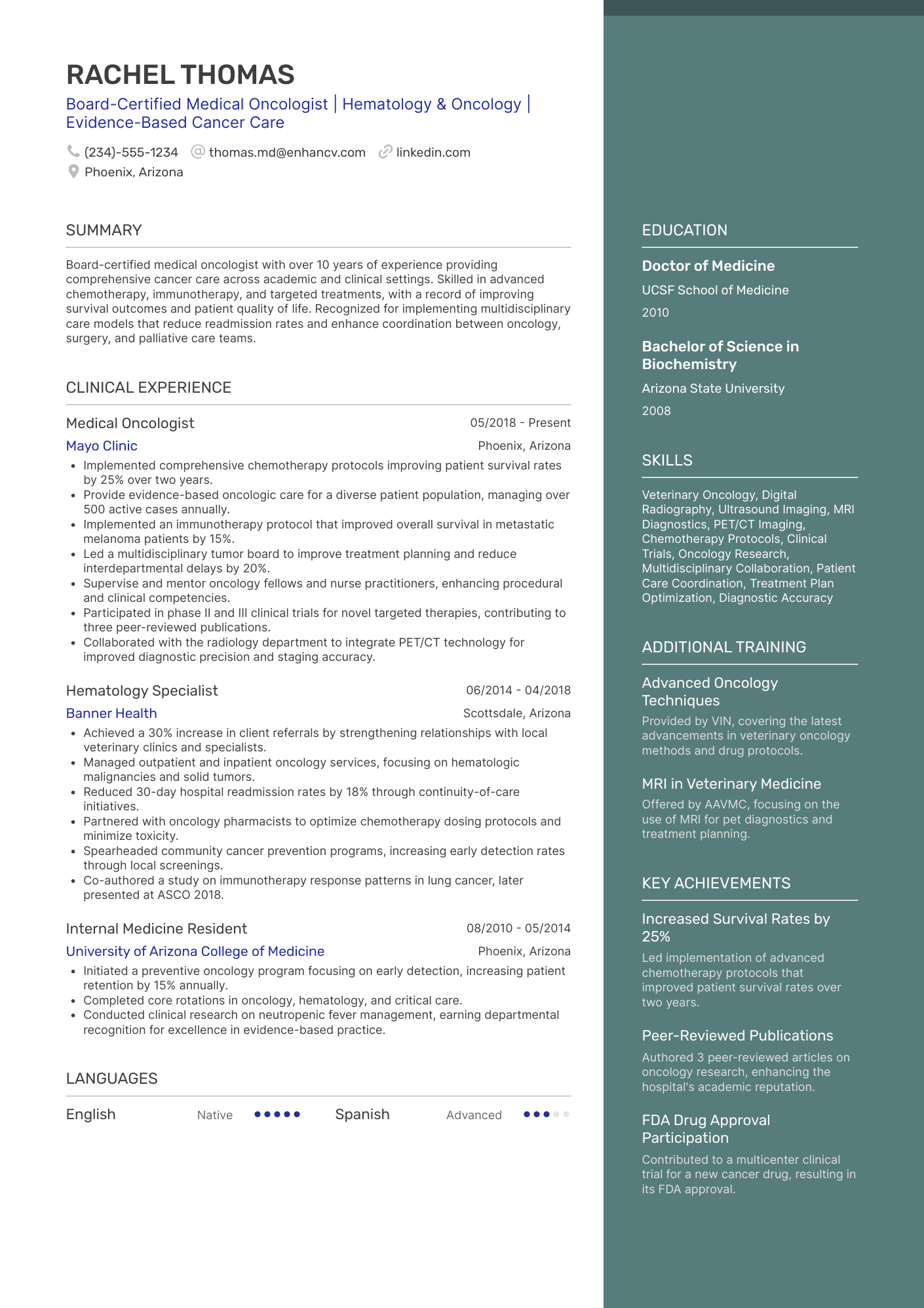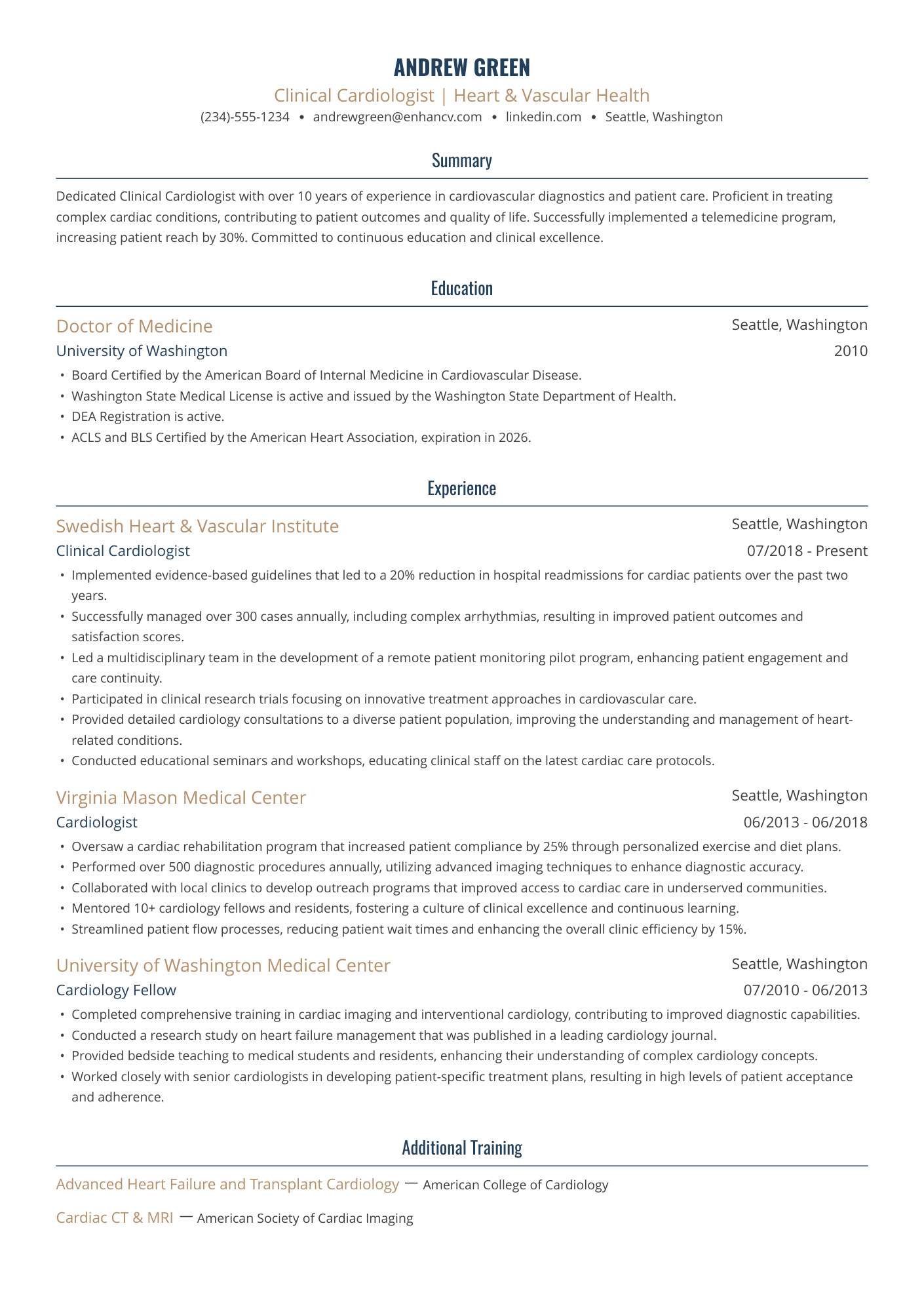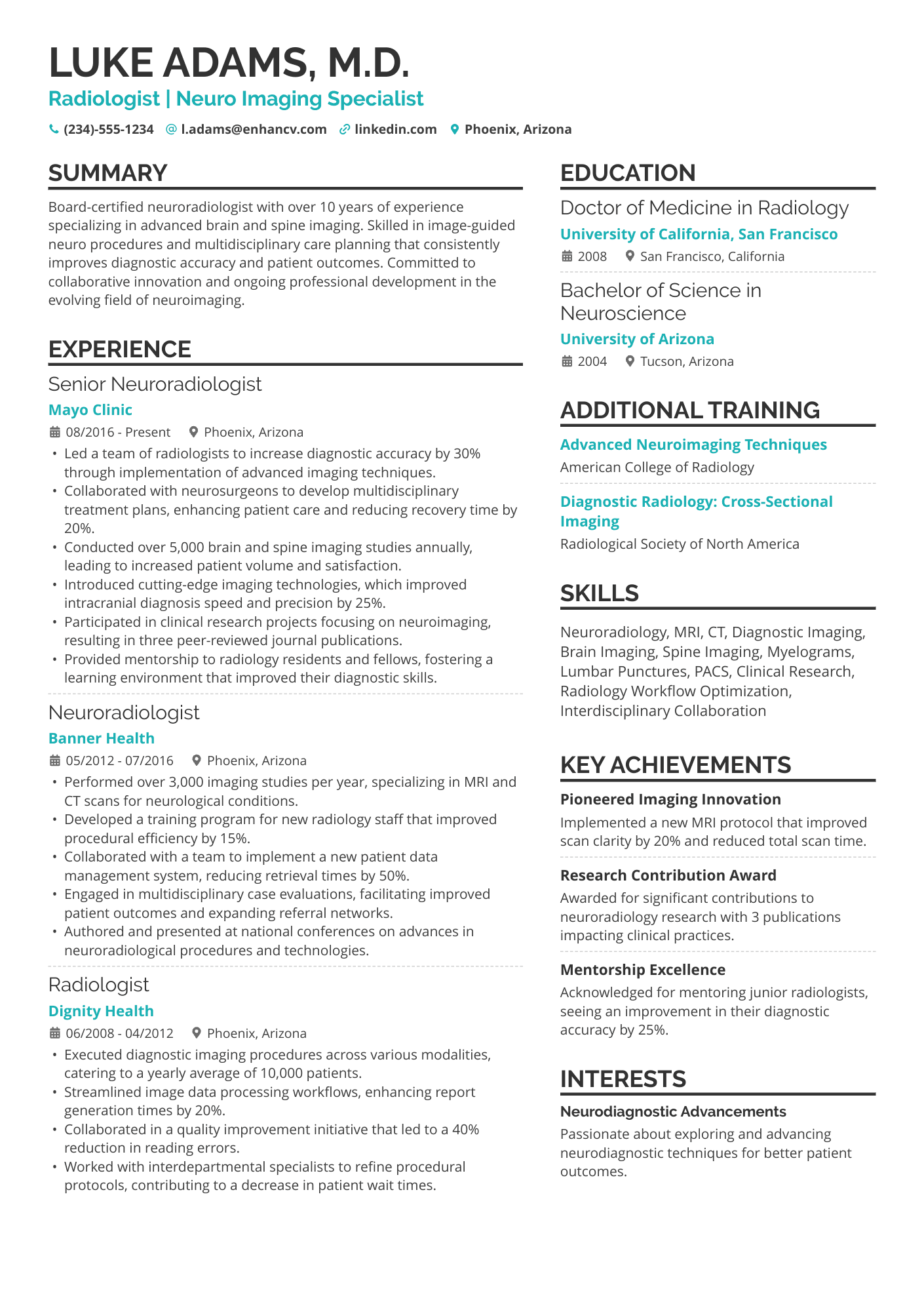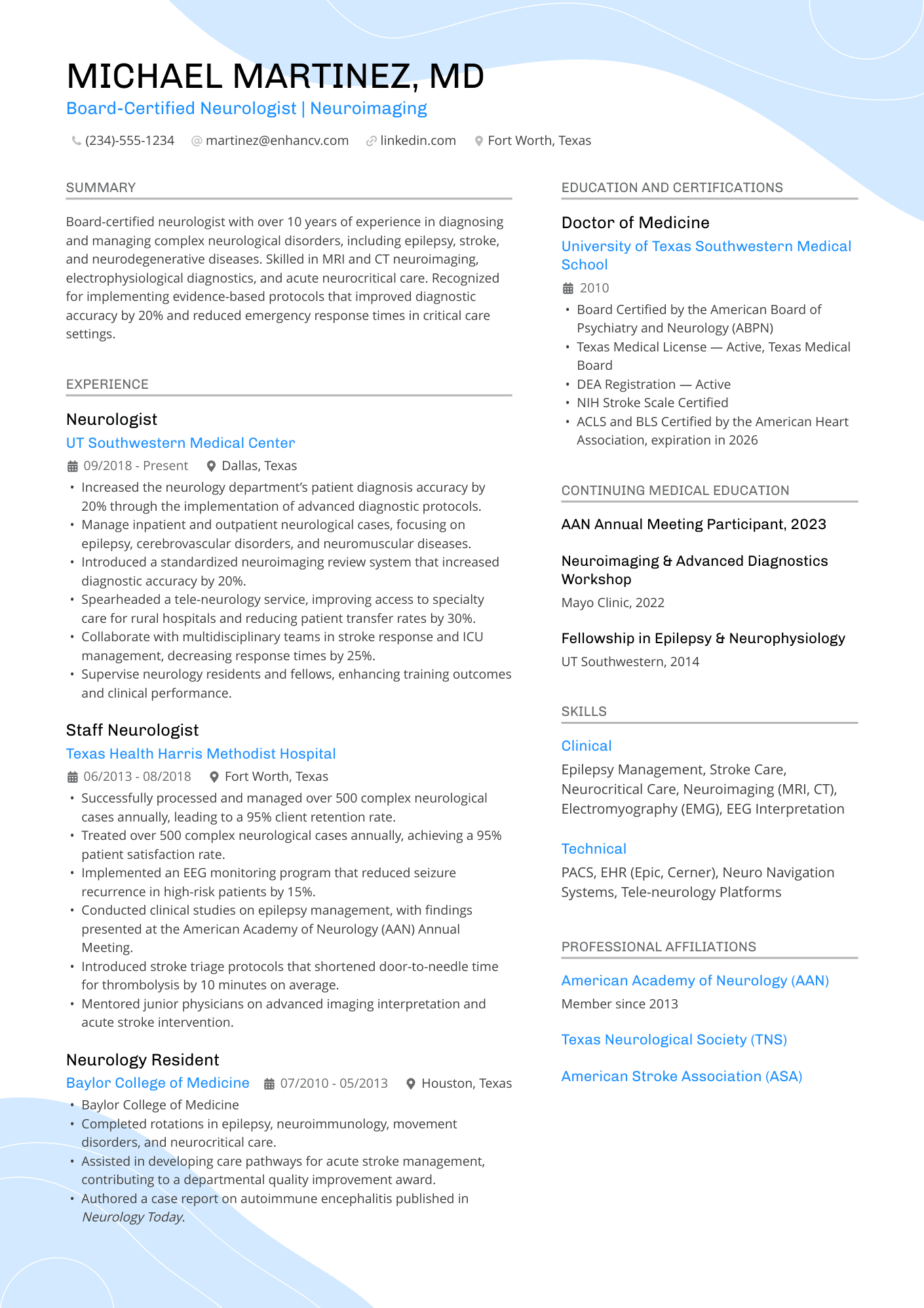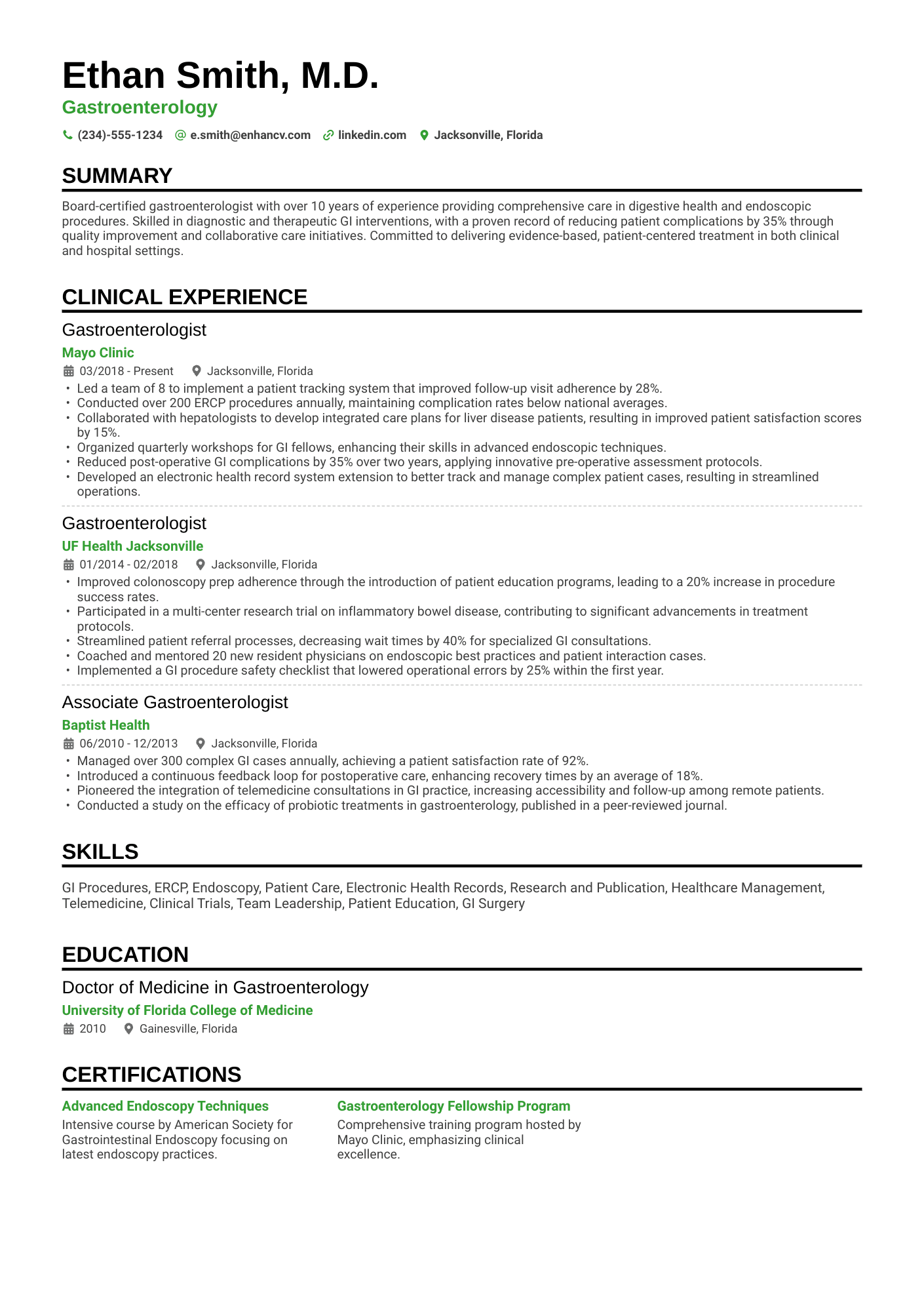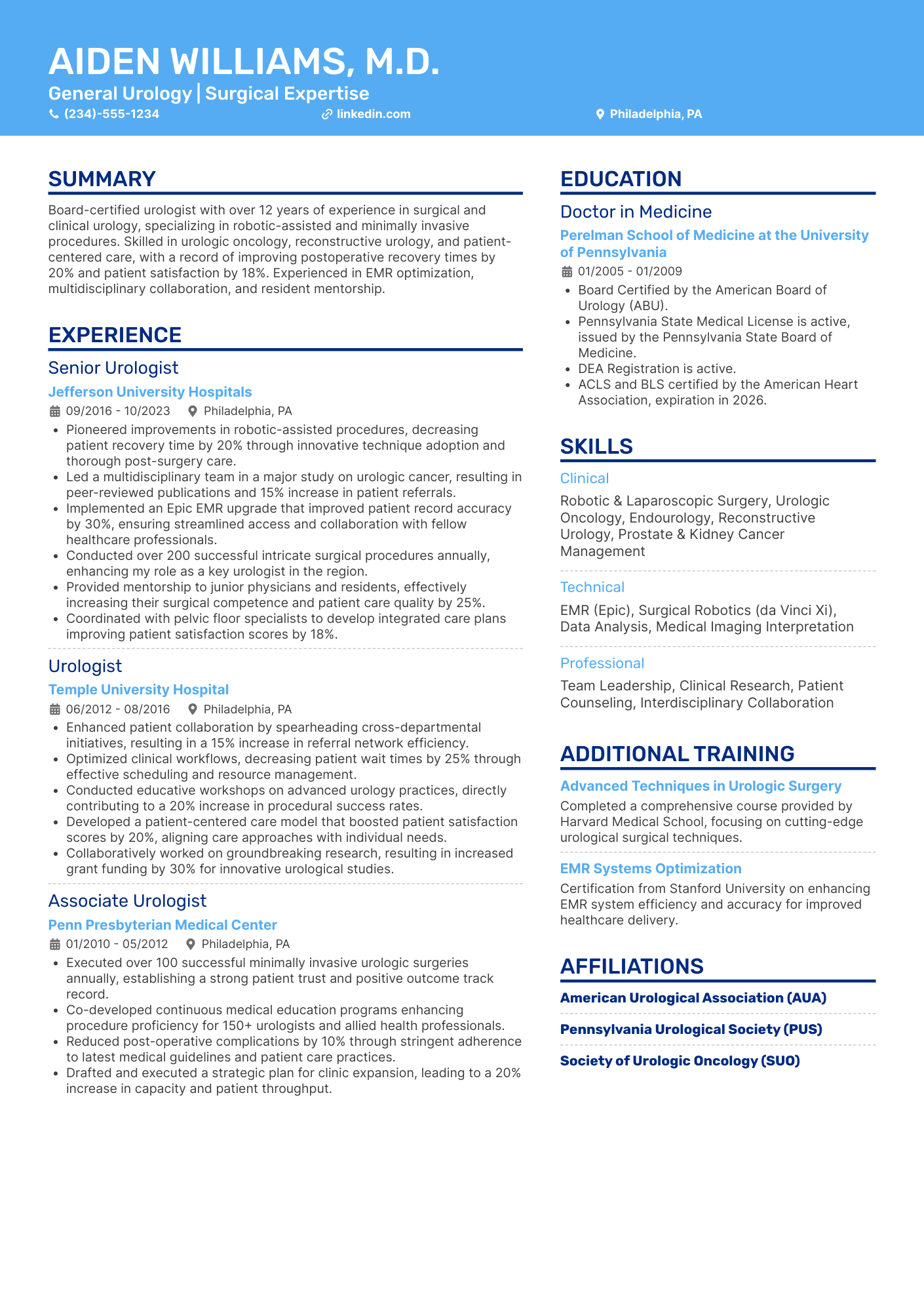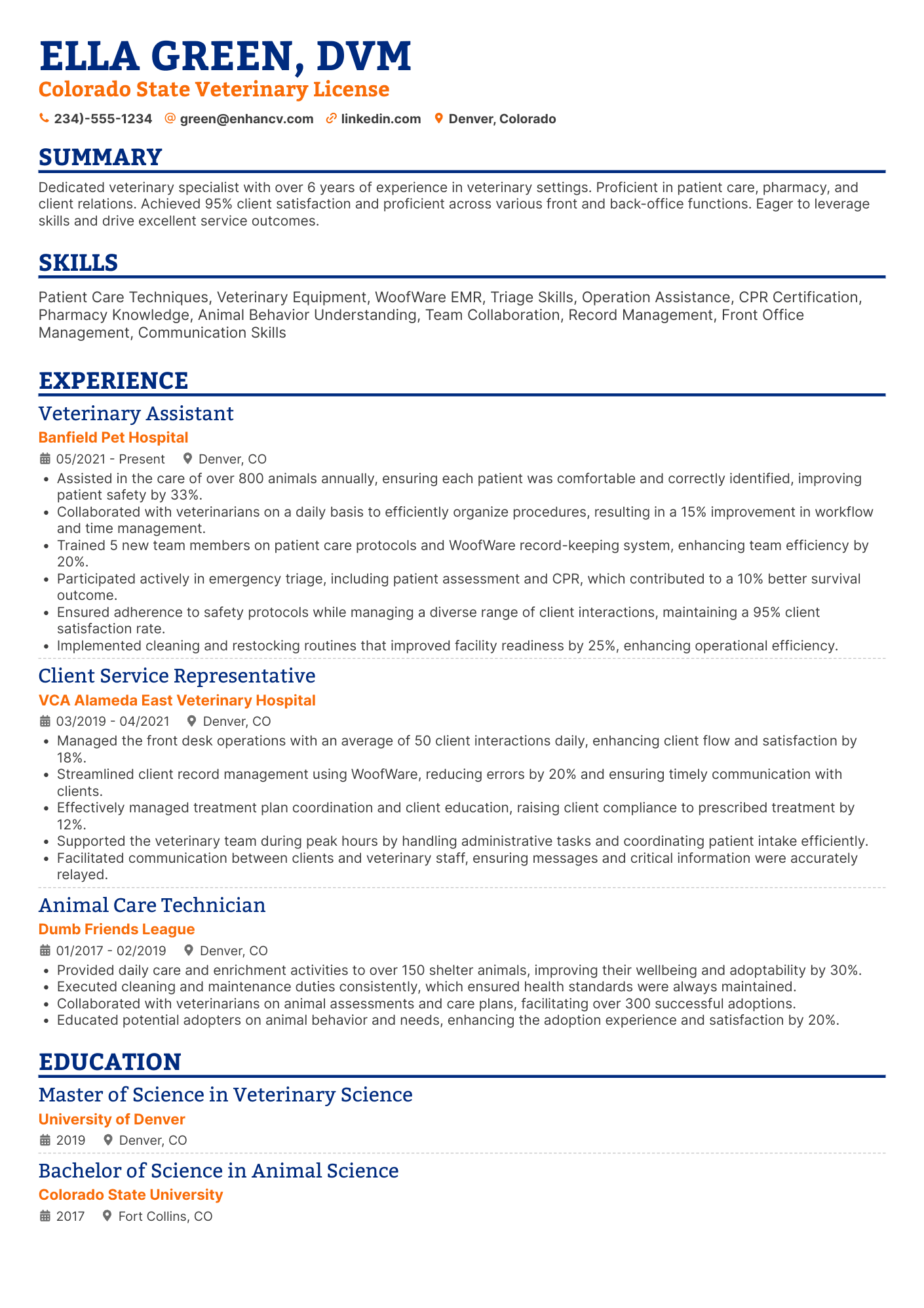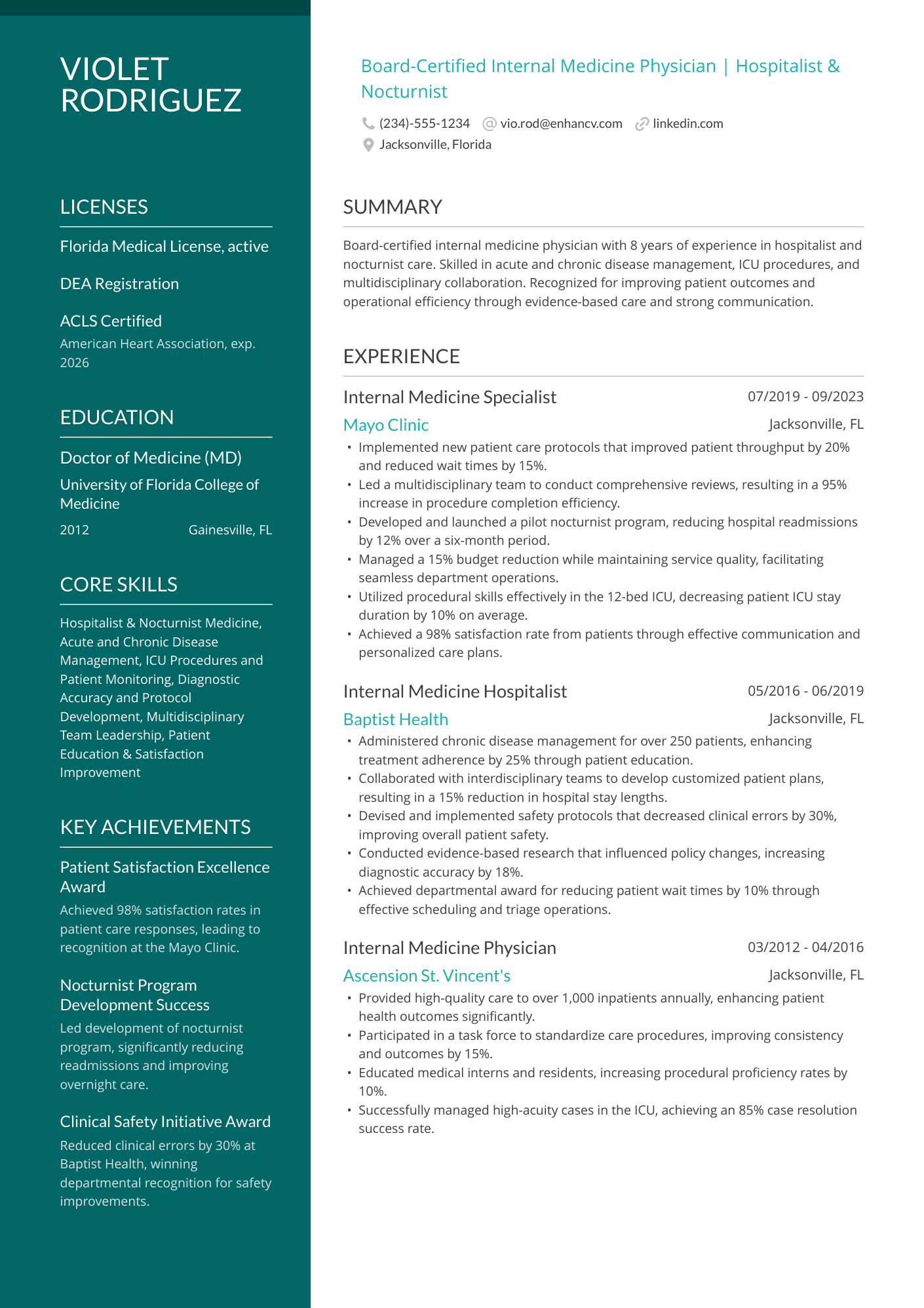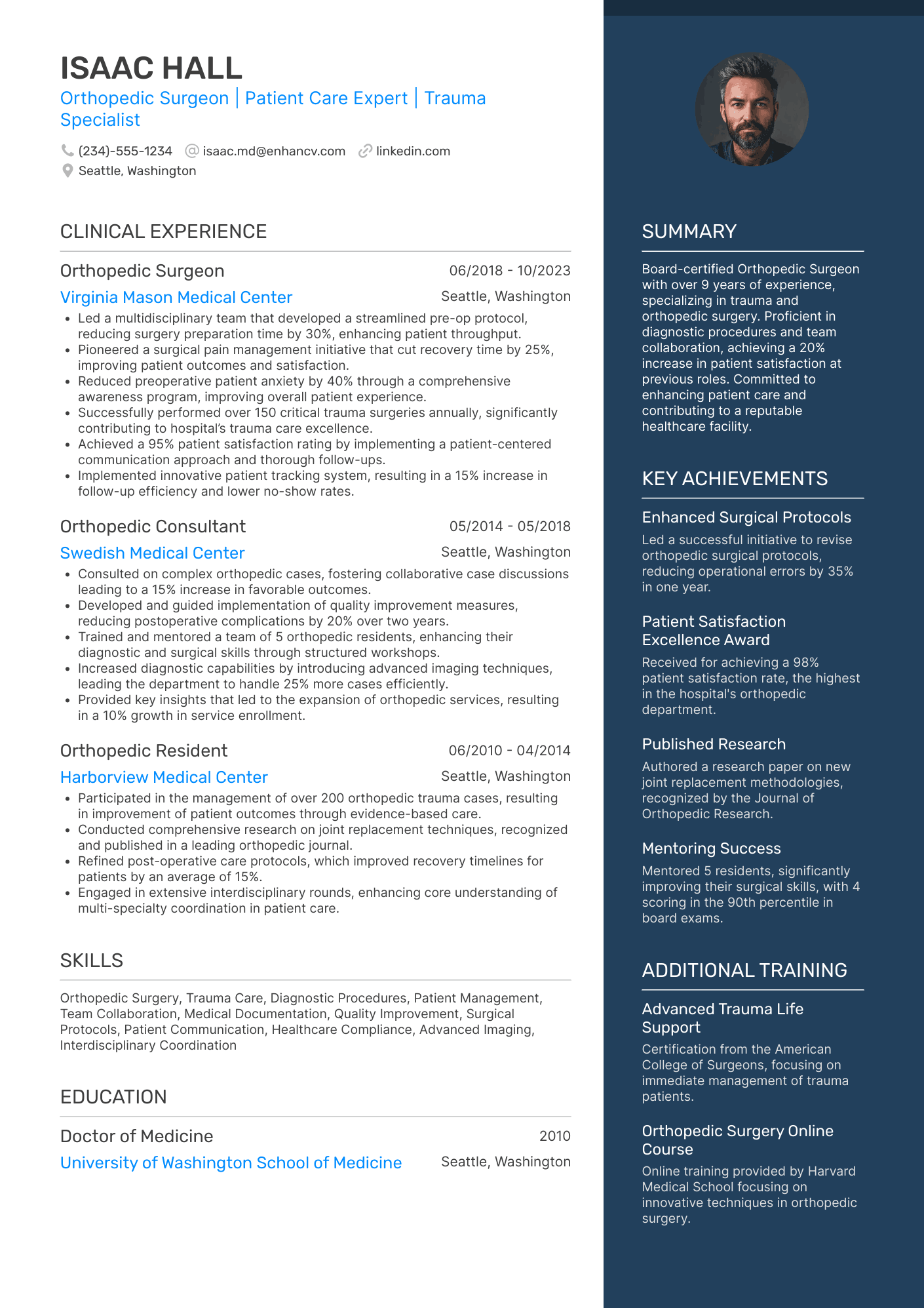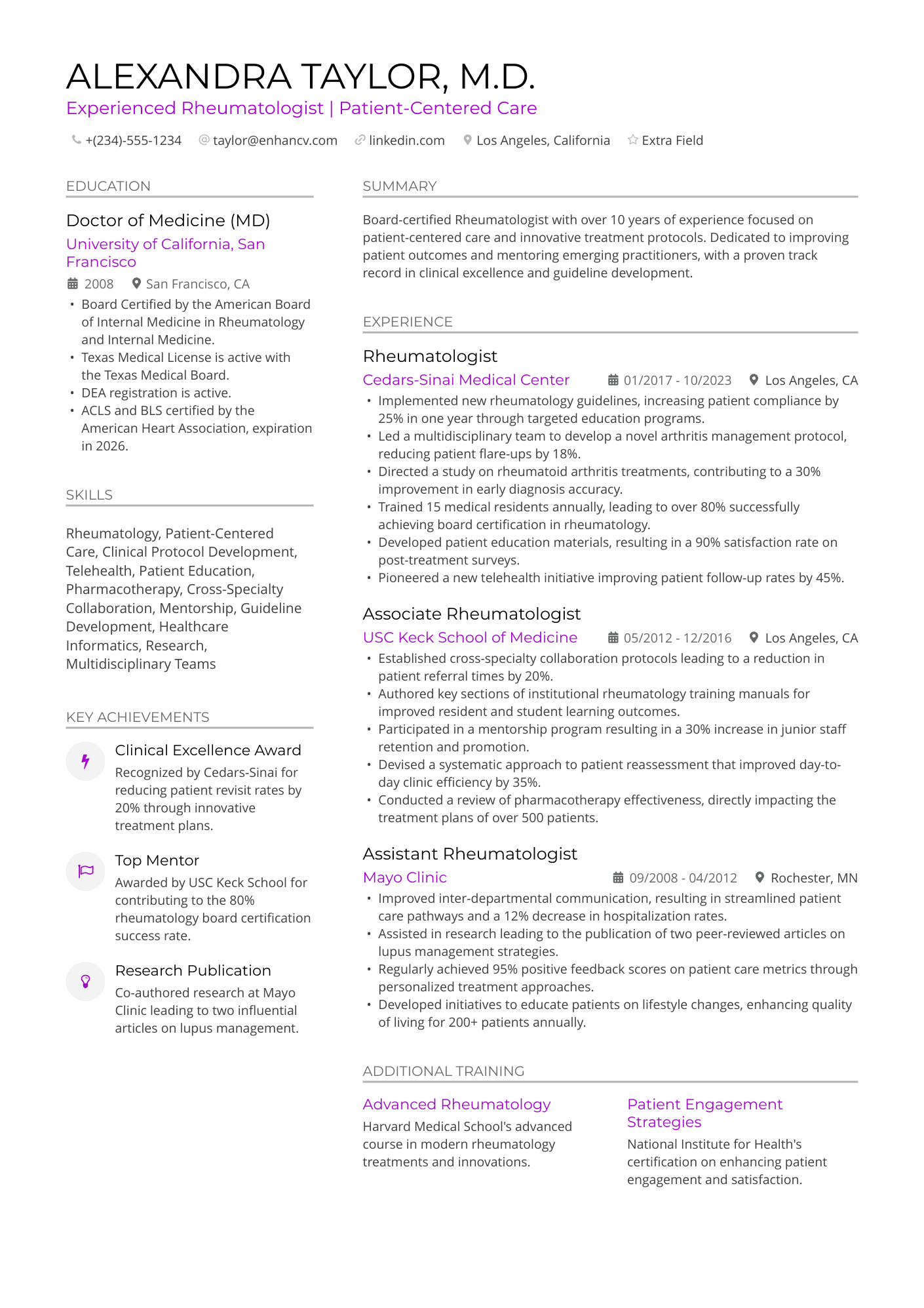A great medical doctor resume does more than list credentials—it shows the difference you make in patients’ lives, your ability to lead clinical teams, and the outcomes you’ve achieved in high-pressure environments.
Whether you’re applying for a hospital leadership role, joining a new healthcare system, or exploring non-clinical opportunities in management or health technology, a clear and well-structured resume helps your expertise stand out.
While some medical roles still require a detailed curriculum vitae (CV)—especially in academia or research—this guide focuses on creating a resume for practicing physicians who are advancing their careers or transitioning into leadership positions.
Here, you’ll find doctor resume examples, templates, and expert insights to help you present your medical experience with confidence and clarity.
Key takeaways
- A doctor resume should highlight measurable outcomes and leadership impact, not just a list of credentials.
- Use a reverse-chronological or hybrid format to make your qualifications easy to verify.
- Avoid academic detail overload—focus on results, patient outcomes, and systems improvement.
- Include relevant keywords and keep formatting simple. Enhancv’s Resume Checker can help ensure your document passes both ATS and human review.
- Update your resume regularly to reflect active licenses, certifications, and evolving areas of expertise.
Before diving into the how-tos, explore our selection of doctor resume examples to see how different MDs present their experience across various medical roles.
Additional resumes for doctors of medicine
By Role
General Practitioner
- Demonstrating capacity for multifaceted roles – Showcasing a diverse history in both urban clinics and rural health posts signals a GP’s capability to swiftly adjust to changing clinical environments and patient populations, an essential trait for handling the unpredictable flow of general practice.
- Aligning with the clinic’s ethos and community values – Referencing involvement in public health initiatives or patient-centered care models that mirror the clinic’s core objectives underlines a sincere understanding of the company’s mission, positioning the candidate as an ideal cultural and professional match.
- Expressing a clear and compelling professional drive – Outlining a genuine passion for front-line medicine, especially if motivated by a desire to improve accessibility for underserved populations, lends authenticity and purpose to the application, distinguishing the GP as both committed and enthusiastic about contributing to the team’s greater goals.
Emergency Room Doctor
- Showcasing preparedness through relevant clinical backgrounds – A compelling Emergency Room Doctor resume emphasizes hands-on experiences in high-acuity environments, such as trauma centers or urgent care settings, displaying the ability to handle rapidly evolving medical crises while efficiently managing multiple patient priorities.
- Aligning professional values with institutional ethos – Demonstrating genuine understanding of the hospital’s mission and approach to patient care illustrates the candidate’s commitment to supporting not just individual outcomes, but the broader healthcare objectives and collaborative culture unique to the organization.
- Integrating specialized emergency medicine language – Effective use of key terminology like "rapid triage," "advanced cardiac life support," and "multidisciplinary care coordination" helps underscore familiarity with essential industry protocols and affirms expertise in procedures specific to the ER setting.
Obstetrics and Gynecology Doctor (OB/GYN)
- Captivating storytelling transforms clinical experiences – A compelling resume stands out when it weaves personal passion and patient-centered commitment into achievements, allowing readers to envision a doctor who is not only medically competent but also deeply invested in the well-being of every patient. Emotionally resonant narratives describing meaningful patient outcomes or showcasing compassionate care help create a lasting impression and highlight empathy as a core professional trait.
- Demonstrated flexibility across varied medical scopes – Prominence is given to candidates who illustrate their readiness to perform in diverse clinical environments, such as seamlessly transitioning between surgical procedures, prenatal care, emergency response, and health education initiatives. Including examples where the physician adeptly adapted to different teams or patient populations emphasizes an ability to thrive in fast-paced or unpredictable situations, essential for today’s multifaceted OB/GYN roles.
- Impact-driven milestones directly tied to women’s health advancements – Highlighting quantifiable accomplishments—such as improving maternal outcomes, leading research in reproductive health, or pioneering minimally invasive procedures—conveys a proven track record relevant to the OB/GYN specialty. Tailoring achievements to align with the priorities of the prospective employer or institution, such as leadership in quality initiatives or community outreach, makes clear the candidate’s capacity to deliver results in their targeted environment.
Pediatric Doctor
- Creating an immediate human connection – A pediatric doctor’s resume truly stands apart when it opens with genuine stories or patient-centered language that conveys empathy and compassion. Sharing brief, relevant anecdotes or framing responsibilities in terms of positive patient impact helps hiring managers instantly see the candidate’s deep commitment to children’s well-being, making the document memorable on an emotional level.
- Highlighting undeniable clinical accomplishments – Demonstrating tangible results, such as initiating a successful immunization outreach that raised vaccination rates or leading a quality improvement project that reduced pediatric hospital readmissions, provides concrete proof of expertise. These metrics and achievements underscore the candidate’s effectiveness and show how their actions have tangibly benefited patients, departments, or communities.
- Ensuring professional identity is front and center – Unsurpassed pediatric resumes echo the same values and professional strengths as showcased on platforms like LinkedIn, presenting a unified narrative. By aligning tone, key skills, and even specific phrases across their documents and online profiles, candidates reinforce a consistent reputation as dedicated, knowledgeable, and trustworthy pediatric specialists.
Dermatologist
- Strategic visual clarity and structured sections – A standout dermatologist's resume benefits from generous spacing, uniform margins, and logical breaks between content clusters such as clinical experience, research work, and professional affiliations. Organized headings and use of bullet points ensure that accomplishments and specialties catch the eye of recruiters without overwhelming them, fostering effortless navigation and quick absorption of qualifications.
- Distinctive professional expertise and demonstrable skillset – In-depth detailing of specialized competencies, such as proficiency in laser therapies, dermatopathology, or procedural dermatology, elevates the resume. Showcasing evidence of board certification, published research, and continuing education reveals both the depth and currency of the applicant’s knowledge, positioning them as a dedicated and highly skilled practitioner in their field.
- Compelling finish backed by clear intent – The closing statements should effectively summarize the candidate’s core strengths while articulating a persuasive desire to contribute meaningfully to the new medical team. A well-crafted call to action, such as expressing an eagerness to discuss how their experience aligns with the clinic’s goals, leaves a memorable impression and prompts further engagement from the hiring committee.
Family Medicine Doctor
- Thorough company insight is showcased – The resume becomes compelling when it references the organization's patient populations, healthcare model, or mission, signaling genuine research and alignment with the practice's values and community focus, rather than offering vague or generic interests.
- An initial scan reveals both breadth and adaptability – The document stands out when it immediately displays a balanced blend of clinical breadth across age groups and strong interpersonal skills, making clear that the candidate is highly adaptable and ready to contribute effectively in a dynamic family medicine setting.
- Incorporation of discipline-specific language enhances relevance – By weaving in sector-relevant terms such as chronic disease management, preventive care protocols, or EMR proficiency, the resume signals both expertise and a clear understanding of best practices within family medicine, helping it resonate with experienced healthcare recruiters.
Internal Medicine Doctor
- Immediate visual impact and clarity of expertise – An outstanding Internal Medicine Doctor resume quickly communicates both the breadth and relevance of clinical experience, educational background, and board certifications, placing the most applicable qualifications at the forefront. A concise, organized layout ensures hiring managers can easily ascertain suitability for complex roles, especially in fast-paced hospital or clinic environments.
- Relevant medical vocabulary and technical fluency – Integrating terms specific to internal medicine—such as differential diagnosis, chronic disease management, evidence-based protocols, and familiarity with electronic health records—demonstrates a deep understanding of the field. Using such industry-specific language signals to medical employers that the candidate can communicate and perform effectively among peers and multidisciplinary teams.
- Impactful final statements and decisive invitation to respond – A compelling resume for this role concludes with a closing that not only recaps unique qualifications and commitment to patient-centered care but also actively encourages further discussion. This closing leaves a memorable impression by confidently inviting an interview, reinforcing both professionalism and genuine motivation to contribute to the healthcare organization.
Anesthesiologist
- Distinctive clinical and technical acumen – A top-tier anesthesia provider emphasizes advanced procedural skills, adaptability with new technologies, and a documented history of rapid, high-stakes decision-making. Highlighting certifications in subspecialties, international medical training, research involvement, or a record of innovative patient safety initiatives instantly distinguishes the candidate from peers who may only list basic qualifications.
- Clean and intuitive visual layout – A standout anesthesiologist resume utilizes crisp section headings, strategic white space, and concise bulleting, ensuring skills and achievements don’t get lost in dense text blocks. Thoughtful arrangement—such as grouping board certifications with advanced airway management, or using clear subheadings for research and teaching experience—allows busy reviewers to swiftly locate vital information.
- Strategic career narrative – By mapping earlier training, employment, and clinical rotations to the expectations of a staff anesthesiologist, the resume demonstrates planned professional growth. Explicit links to key aspects—like perioperative leadership, multidisciplinary collaboration, or managing complex cases—underscore readiness for the specific institution’s needs, assuring hiring boards of a candidate’s seamless integration and long-term potential.
Psychiatrist
- Inviting closure through impactful final statements – A psychiatrist doctor’s resume leaves a lasting impression when the closing lines clearly articulate the candidate’s dedication to advancing mental health care and their eagerness to discuss next steps. This section becomes memorable when it concisely encapsulates the candidate’s passion and readiness for impactful collaboration, while extending a warm yet professional invitation for an interview or conversation.
- Attention to clear, inviting layout and presentation – Noteworthy resumes in psychiatry balance legible formatting, generous section spacing, and clean typefaces to effortlessly lead the eye from credential to accomplishment. White space, succinct bullet points, and well-defined headings ensure that clinical experience, research endeavors, and specialized training are easy to scan, enabling hiring managers to quickly glean key qualifications without visual fatigue.
- Professional brand echoes across platforms – Consistency between the resume and the individual’s LinkedIn profile communicates intentionality and professionalism. By aligning language, core values, and expertise areas, the psychiatrist underscores their unique approach to patient care, signaling reliability and coherence in their digital footprint to recruiters and hospital administrators alike.
Endocrinologist
- Demonstrating robust clinical expertise and specialty training – Highlighting a comprehensive background in managing complex endocrine disorders, such as diabetes, thyroid diseases, and metabolic syndromes, underscores the physician’s technical mastery and up-to-date knowledge of the latest clinical protocols. Evidence of board certification, ongoing medical education, and participation in research or advanced fellowships signals a commitment to excellence in endocrinology.
- Showcasing progressive experience relevant to endocrine care – A standout resume draws clear connections between prior medical roles and the unique challenges of an endocrinology practice. Detailing accomplishments—like leading multidisciplinary teams, implementing patient-centered care models, or contributing to improved treatment outcomes—demonstrates how previous positions have shaped a focused and well-aligned career trajectory in the endocrine field.
- Ending with a strong, actionable closing that inspires follow-up – Concluding with a confident summary or a forward-looking call to action, such as expressing eagerness to bring advanced endocrinology skills to the hiring institution, reinforces the candidate’s enthusiasm. A well-crafted closing not only articulates the value offered but also encourages further conversation, ensuring the resume leaves a lasting impression on recruiters.
Oncologist
- Crisp layout and inviting whitespace enhance first impressions – An oncologist's resume benefits greatly from a design that utilizes generous spacing and clear, uniform paragraph breaks. This arrangement reduces clutter and allows each accomplishment to capture the reader's attention, making the document approachable even amid dense medical terminology. Strategic use of bold headings also aids skimmability for recruiters screening numerous applications.
- Logical arrangement and prioritization underscore strengths – Outstanding resumes segment qualifications in a deliberate order, often beginning with a powerful summary followed by an easily navigable display of certifications, fellowships, and clinical roles. Bullet points succinctly convey quantifiable achievements, ensuring that the most relevant experiences and areas of expertise rise to the top for prospective employers.
- Demonstrated expertise through tangible results and specializations – A compelling oncologist CV clearly outlines advanced clinical skills, research contributions, and any subspecialty focus, such as hematologic or pediatric oncology. Highlighting outcomes like clinical trial leadership, patient survival improvements, or published studies provides concrete evidence of professional impact that resonates strongly with hiring committees.
Cardiologist
- Demonstrated flexibility in clinical and research settings – A standout cardiologist resume highlights diverse adaptability, such as thriving in both high-pressure emergency departments and collaborative multidisciplinary research teams, signaling readiness to embrace varied challenges and patient populations.
- Clear passion for advancing cardiovascular medicine – Effective resumes reveal a deep personal drive by outlining how the candidate’s professional journey aligns with their commitment to improving cardiac care, whether through innovation, patient outcomes, or lifelong learning, making their intent to join the field genuinely compelling.
- Insightful alignment with the hospital’s mission and values – Top applications display careful research by referencing the institution’s unique programs, culture, or recent cardiovascular initiatives, demonstrating not only knowledge of but also enthusiasm for contributing to that specific environment.
Radiologist
- Strategic use of layout for clarity – A Radiologist Doctor resume commands attention when it leverages consistent margins, organized headers, and plenty of white space to separate sections. Bullet points and concise paragraphing contribute to effortless readability, ensuring a recruiter can instantly locate board certifications, technical skills, and key accomplishments without struggling through dense blocks of text.
- Compelling summary of specialized expertise – What truly distinguishes a standout applicant is a summary that not only lists subspecialty training (like neuroradiology or pediatric imaging), but also highlights rare procedural skills and a proven record of diagnostic accuracy. Integrating quantifiable achievements—such as efficiency improvements or reductions in report turnaround time—conveys tangible value far beyond standard qualifications.
- Impactful conclusion supporting further engagement – A persuasive closing section elevates the resume by reaffirming clinical excellence and teamwork, then invites a dialogue by expressing genuine enthusiasm to contribute to the institution's mission. This approach replaces generic statements with a clear call to action, motivating the reader to initiate an interview and learn more about the candidate's unique strengths.
Neurologist
- Demonstrates proficiency through precise neurological language – An outstanding neurologist resume consistently weaves in specialized terminology such as “electromyography,” “epileptiform activity,” or “neuroimaging interpretation,” reflecting deep engagement with current clinical practices and research advancements. This targeted vocabulary not only exhibits familiarity with the complexities of neurology but also signals to potential employers a genuine expertise in the field’s unique diagnostic and treatment protocols.
- Highlights transformative outcomes and quantified progress – What distinguishes a top-tier neurologist’s resume is the inclusion of tangible achievements, for example, leading a stroke intervention initiative that reduced response time by 25%, or authoring research that influenced updated treatment guidelines. Such evidence-backed results showcase a candidate’s ability to drive clinical improvements, innovate in patient care, and contribute meaningfully to institutional growth or broader medical practice.
- Showcases readiness to thrive in varied neurology environments – The most effective resumes underscore flexibility, such as successfully transitioning between academic settings, private clinics, and hospital departments, or integrating telemedicine into patient management during public health crises. By demonstrating adaptability across different healthcare systems, patient populations, and evolving technologies, the neurologist positions themselves as both resourceful and agile within a dynamic medical landscape.
Gastroenterologist
- Impactful introductions set the stage for excellence – A gastroenterologist’s resume truly shines when the opening lines capture the breadth of clinical expertise while showcasing advanced procedural skills and a patient-centered mindset. Briefly detailing signature achievements or specialized interests within the first paragraph immediately demonstrates value to hiring committees and piques their interest to read further.
- Personal branding aligned across platforms builds recognition – When the resume mirrors the professional narrative and voice found on the candidate’s LinkedIn profile, it establishes credibility and trust. Consistency in presenting board certifications, research involvement, and leadership in medical associations ensures employers see a coherent and memorable professional identity.
- Tightly organized details highlight core competencies – A standout resume for this specialty distills complex duties and accomplishments into succinct bullet points, avoiding dense paragraphs or unnecessary jargon. By prioritizing clarity and brevity, the document enables recruiters to quickly appreciate procedural proficiency, patient outcomes, and scholarly contributions.
Orthopedic Doctor
- Clearly demonstrated passion for orthopedic healthcare – An outstanding orthopedic doctor resume clearly conveys a deep-seated commitment to the specialty, articulating both personal and professional motivations for pursuing orthopedics. By succinctly outlining experiences that inspired their focus—such as impactful clinical rotations or meaningful patient outcomes—it distinguishes the candidate as someone with purposeful intent and long-standing interest in musculoskeletal medicine.
- Poised and energetic presentation throughout – The document maintains a harmonious blend of professionalism and vigor, reflecting a candidate who not only understands the seriousness of the field but also brings a sense of purpose and excitement to their work. This balance is achieved through confident yet personable language, making the candidate appear both reliable and genuinely invested in advancing orthopedic care.
- Effective integration of orthopedic-specific vocabulary – To capture attention in a competitive specialty, the resume adeptly weaves in technical terms such as arthroplasty, fracture fixation, joint reconstruction, and evidence-based rehabilitation protocols. By doing so, it demonstrates the applicant's fluency in the crucial language and concepts of orthopedics, assuring evaluators of their advanced understanding and practical capability within the discipline.
Rheumatologist
- Demonstrates fluency with medical terminology and subspecialty expertise – An exceptional Rheumatologist resume seamlessly incorporates advanced language such as “immunomodulatory therapy,” “diagnostic musculoskeletal ultrasound,” and “serologic markers interpretation,” conveying a robust grasp of both clinical knowledge and evolving trends in rheumatic disease management. This strategic usage of technical terminology assures employers of the candidate’s deep-rooted proficiency and up-to-date expertise in the specialty.
- Conveys passionate commitment to advancing rheumatologic care – A standout application clearly articulates the individual’s drive for pursuing a Rheumatology career, expressing a genuine enthusiasm for improving patient quality of life, advancing treatment protocols, and collaborating within multidisciplinary teams. Employers value applicants who not only have the credentials but also demonstrate an intrinsic motivation to contribute to patient-centered, progressive care in their field.
- Immediately projects alignment with institutional needs and patient population – From the outset, a compelling Rheumatologist CV immediately signals alignment with the specific requirements of the position, such as prior experience in academic centers, proficiency in managing complex autoimmune disorders, or a proven record of research and community engagement. This immediate suitability creates a positive first impression, distinguishing the applicant as not only capable but also particularly well-matched for the intended role.
Urologist
- Crafting a persuasive conclusion elevates impact – An exceptional Urolog Doctor resume is distinguished by a forceful closing section that not only summarizes key qualifications but also issues a confident invitation for further discussion. This well-considered call to action demonstrates initiative and readiness for the position, setting the applicant apart as both assertive and approachable, which is highly valued in the medical profession.
- Explicit motivation for seeking this opportunity guides the reader – What distinguishes a memorable urology CV is the applicant’s ability to clearly articulate why they are passionate about joining a particular healthcare institution or team. Articulating specific reasons such as a shared commitment to innovation in surgical techniques or dedication to patient-centered care shows thoughtful intent, reinforcing the alignment between the candidate’s values and the employer’s mission.
- Balanced expression achieves optimal tone – The most compelling resumes in this field strike a careful equilibrium between professionalism and enthusiasm, ensuring the language remains authoritative while also conveying genuine excitement for the urology role. This combination assures hiring managers that the candidate not only possesses clinical and technical expertise, but also brings energy and a positive attitude essential for patient interaction and collaboration with colleagues.
Veterinary Doctor
A great veterinarian resume should show more than your love for animals — it should demonstrate your medical expertise, surgical skill, and ability to build trust with pet owners. Whether you work in a small animal clinic, a specialty hospital, or a research setting, your resume needs to reflect precision, empathy, and leadership.
How to choose the best doctor resume format
Recruiters and hospital administrators reviewing physician resumes look for clarity, credibility, and a consistent career story. The format you choose determines how easily they can see your qualifications, leadership experience, and clinical results.
Most medical doctors should use a reverse-chronological format, as it highlights your most recent and relevant clinical experience first. This structure helps hiring teams quickly verify your credentials, licenses, and scope of responsibility—all crucial in healthcare hiring.
If you’re shifting from clinical practice to administration, consulting, or health tech, a hybrid (combination) format works best. It lets you spotlight transferable skills—like operational management, data-driven decision-making, or patient safety leadership—while still presenting a clear work history.
What sections should go on a doctor's resume?
A well-structured physician resume typically includes:
- Header: Full name, medical credentials (e.g., MD, DO), contact details, and a professional profile link (LinkedIn or Doximity)
- Professional summary: A brief snapshot of your specialty, years of experience, and key achievements
- Clinical experience: Your practice settings, patient population, and measurable outcomes or leadership impact
- Education and medical training: Medical school, residency, and fellowships in reverse-chronological order
- Certifications and licenses: Board certifications, state licenses, and continuing education relevant to your specialty
- Core skills: Clinical expertise, diagnostic proficiency, and interpersonal or administrative skills that support patient care and team performance
- Optional sections: Research contributions, publications, conference presentations, or professional affiliations (e.g., AMA, AAFP, ACP)
The sections you include—and the emphasis you give each—should align with your target role. A professional moving into hospital leadership, for example, might prioritize management and quality improvement achievements over research or publications.
Once you’ve outlined your sections, it’s worth checking how your resume performs before you send it out. With Enhancv’s Resume Checker, you can instantly see how your doctor resume scores on structure, keywords, and clarity—and get personalized suggestions to make it stronger.
Is your resume good enough?
Drop your resume here or choose a file. PDF & DOCX only. Max 2MB file size.
How to write your doctor resume experience
Your experience section should give a clear sense of what you do every day and why it matters. Think of it as a way to show the scope of your work, the settings you’ve practiced in, and the difference your care or leadership has made.
Keep each entry focused. Start with where you worked and your role, then use a few short bullet points to show what you achieved or improved. Instead of listing clinical duties, describe the impact of your decisions—whether it’s better patient outcomes, smoother operations, or a more confident team.
Here’s what a strong entry might look like:
Good example of a doctor's experience section
Attending Physician
Internal Medicine | Cleveland Clinic, OH
2018–2020
- Managed a patient panel of over 1,000 adults, maintaining a 92% chronic disease management compliance rate.
- Introduced an EHR workflow that cut documentation time by 20% while improving data accuracy.
- Mentored a team of eight residents, fostering collaboration and evidence-based practice.
Avoid listing medical school rotations or required training once you’ve completed residency—they belong on a CV, not a resume. Here, focus on your post-training clinical roles and measurable contributions.
How to tailor your doctor resume experience
In medicine, job descriptions can sound almost identical, but the expectations behind them rarely are. Tailoring your resume isn’t about rewriting your story, but about choosing which parts of your experience matter most for the role in front of you.
Here’s how to approach it:
- Read the job posting like a patient chart: identify the priorities, such as patient outcomes, leadership, operational efficiency, or teaching.
- Match their language: if they emphasize “care coordination,” use that phrase where it fits naturally.
- Highlight relevant scale: patient volume, team size, or department scope signal your level of responsibility.
- Show results tied to their goals: improved discharge rates, lower readmissions, higher satisfaction scores.
- Leave out what’s routine: focus on what distinguishes you in your field, not what every clinician does daily.
PRO TIP
Following these steps also helps your resume pass through healthcare-specific ATS systems, which often screen applications based on required qualifications or key medical terms.
To put this in context, let’s look at how two tailored resume bullets might read when aligned with real physician job postings.
Resume tailoring for a hospital medicine physician
Job description excerpt
MD or DO, Board Certified or Board Eligible in Family Medicine or Internal Medicine. 1–2 years of experience preferred, with a focus on collaboration with APCs in the hospital medicine setting.
Tailored resume bullet
Provided inpatient care in collaboration with advanced practice clinicians, managing 14–18 patients daily and supporting continuity between hospitalist and specialty teams.
Notice how the bullet takes a basic requirement—”working collaboratively in a hospital setting”—and turns it into proof of scope and impact.
Here’s how that same approach applies to a different physician role:
Resume tailoring for a medical director
Job description excerpt
Seeking a dedicated and experienced Medical Director (MD or DO) to lead a clinical team and oversee the delivery of high-quality patient care. Requires strategic thinking and expertise in men’s health.
Tailored resume bullet
Lead a multidisciplinary clinical team focused on preventive and hormone health, introducing standardized care pathways that increased patient follow-up compliance by 15% in the first year.
Tailoring shows that you understand what the hospital or clinic truly needs—and helps your resume stand out to both hiring committees and ATS systems. Start with a master resume that includes all your experience, then create tailored versions for specific job ads. With Enhancv’s One-Click Tailoring Tool, you can paste the job description and instantly adjust your bullets, skills, and summary to match the role.
How to quantify your experience on an MD resume
Unlike an academic CV, where you’d list every training program, rotation, and publication, a resume is meant to help hiring managers see your impact quickly. In this format, it’s less about documenting everything you’ve done and more about showing the difference you’ve made.
That’s where numbers come in. Quantifying your work helps translate medical expertise into measurable outcomes—the kind of proof hospitals and healthcare employers look for when choosing their next physician.
Here are a few simple ways doctors can quantify their results:
- Patient outcomes: improvement rates, readmission reductions, or chronic disease management compliance.
- Efficiency metrics: shorter wait times, higher throughput, or reduced documentation time.
- Patient experience: satisfaction or follow-up adherence percentages.
- Leadership impact: number of staff supervised, programs implemented, or departments supported.
- Operational performance: cost savings, improved scheduling accuracy, or reduced medical errors.
You don’t need numbers everywhere—just enough to show the scale and effect of your decisions.
Example: “Reduced outpatient wait times from 45 to 25 minutes by coordinating a new triage protocol and cross-training nursing staff.”
If you’d like help turning your results into strong, measurable statements, try Enhancv’s Bullet Point Generator. It creates clear, results-driven bullets in seconds—you just need to fine-tune them to sound like you.
How to list your medical skills on a resume
A doctor’s skill set goes far beyond clinical expertise. Hospitals and healthcare organizations look for physicians who can balance precision in diagnosis with leadership, communication, and sound judgment. Your skills section should make that balance visible.
To keep it clear and focused:
- Group your skills into Clinical Skills and Professional/Leadership Skills.
- List 6–10 skills total—enough to show range, but not overwhelm.
- Prioritize the ones that reflect your target role. For instance, a hospitalist might highlight care coordination and EHR proficiency, while a medical director emphasizes team leadership and quality improvement.
- Avoid clichés like “hard-working” or “dedicated.” Instead, use terms that speak the language of medicine and results.
Example structure
Clinical Skills
Diagnostic evaluation, EHR (Epic, Cerner), acute patient management, clinical decision support
Professional Skills
Team leadership, interdisciplinary collaboration, performance improvement, patient communication
In most medical roles, core clinical skills are a given. Every professional is trained to diagnose, treat, and manage patients safely. What increasingly sets candidates apart are the digital and data-driven tools they’re comfortable using. From virtual care platforms to AI-assisted diagnostics, these are the skills that show you can keep pace with how modern healthcare works.
Here are some high-value technical skillsworth including on today’s doctor resumes:
Best hard skills for a medical doctor resume
- Electronic Health Record (EHR) proficiency (Epic, Cerner, Allscripts)
- Telemedicine and remote patient monitoring
- Clinical data analysis and outcome tracking
- AI-assisted diagnostic tools and imaging interpretation
- Digital documentation and e-prescribing systems
- Workflow optimization through clinical decision support tools
- Healthcare compliance and data security awareness (HIPAA, GDPR)
- Use of predictive analytics or population health dashboards
For doctors, the idea of separating hard and soft skills doesn’t quite fit. Medicine depends on how clinical expertise and human connection work together—a technically excellent physician who can’t build trust or communicate clearly won’t stand out for long.
These are the interpersonal skills that matter most in healthcare—the ones that define how you work with patients, families, and colleagues.
Best soft skills for doctors
- Empathy
- Team collaboration
- Leadership
- Emotional intelligence
- Conflict resolution
- Adaptability
- Cultural competence
- Ethical judgment
- Time management
- Teaching and mentoring
- Working under pressure
- Strong work ethic
Many of these strengths fit best when woven naturally into your resume summary or experience section—where they can be shown through context, not listed outright. Most medical recruiters don’t expect a separate section for them, so use that space to highlight your hard skills instead.
How to list medical education and licenses on your resume
For doctors, education is one of the most important sections on the resume. It shows where you trained, the specialty you pursued, and that your path meets the requirements to practice medicine safely.
If you’re an established physician, you don’t need to include every academic milestone or certification update. Focus on the credentials that verify your clinical authority and current qualifications.
Most doctors include:
- Medical degree (MD, DO, MBBS, or equivalent)—with school name and graduation year
- Residency and fellowship training, including specialty, institution, and completion year
- Optional: notable honors, distinctions, or leadership roles during training (e.g., Chief Resident)
For example:
Education on a doctor’s resume
Doctor of Medicine (MD)
University of Michigan Medical School | Ann Arbor, MI
2015
Residency, Internal Medicine
Massachusetts General Hospital | Boston, MA
2018
Fellowship, Cardiology
Johns Hopkins Hospital | Baltimore, MD
2021
If you hold multiple credentials, it’s best to separate licenses and board certifications into their own short section. It makes your resume easier to scan, especially for hospital recruiters or credentialing staff who are looking specifically for active status and board eligibility.
Here’s how this can look on your resume:
Licenses and certifications resume sample
- Board Certified, American Board of Internal Medicine, 2021
- State Medical License, Maryland (Active)
- DEA License # [optional]
Before you move on, make sure you’ve double-checked the points below:
Top requirements to keep in mind for MD certifications and licenses
- Active status: Always specify whether your license is current—expired credentials can raise red flags.
- State or regional authority: Mention the state(s) or governing body where you’re licensed to practice.
- Board certification: Include the official issuing board (e.g., American Board of Family Medicine), not just the specialty.
- Renewal or recertification: Note recent renewals or maintenance of certification (MOC) to show ongoing professional compliance.
- Unique credentials: If applicable, include identifiers like DEA registration, NPI number, or international equivalents, but only when relevant to your application.
Once your credentials are in order, it’s time to focus on the part of your resume that brings everything together—your professional profile.
How to write your doctor resume summary
For doctors, the summary is this short paragraph where first impressions form. It’s your chance to make your expertise memorable before anyone scrolls further.
A strong summary should include:
- Your title and specialty (Board-Certified Internist, Emergency Physician, etc.)
- Years of experience and practice setting (e.g., academic hospital, private clinic, telemedicine)
- Core areas of expertise that reflect your focus
- One or two measurable results that prove your effectiveness (improved patient outcomes, reduced wait times, led a team of 15 clinicians)
- A brief statement of approach or values, such as patient-centered care or clinical innovation
Take a look at a good example:
Example summary
Board-certified family physician with 12 years of experience providing comprehensive primary care across urban and rural clinics in North Carolina. Skilled in chronic disease management, preventive medicine, and patient education, with measurable improvements in hypertension and diabetes control rates across a 1,200-patient panel. Known for combining evidence-based care with a personal, approachable style that builds long-term trust and adherence.
Give your resume summary a quick check-up with Enhancv’s Summary Checker.
Fail-proof your summary now.
Drop your resume here or choose a file.
PDF & DOCX only. Max 2MB file size.
How to write a doctor resume with limited experience
Every physician starts somewhere. If you’ve recently finished medical school, residency, or fellowship, your resume will naturally lean more on education and training than long-term employment. That’s expected and perfectly fine.
Here’s how to make your early-career resume work:
- Lead with your education and training: This is where your clinical exposure and specialty focus come through.
- Highlight rotations or fellowships that match your target role, especially if they involved specific procedures, patient populations, or research.
- Include certifications and licenses early—they prove readiness to practice.
- Emphasize skills and achievements gained during training: teamwork, diagnostic accuracy, or patient outcomes in supervised settings.
- Add relevant volunteer work or public health projects to show commitment and initiative.
Take a look at this medical doctor resume template. You can use it as a reference in Word or build your own version with Enhancv’s AI Resume Builder for a polished, personalized result.
John A. Patel, MD
john.patel@email.com | (312) 555-9247 | LinkedIn | Chicago, IL
Summary
Recent internal medicine residency graduate from Northwestern Memorial Hospital with hands-on experience in acute care, patient counseling, and chronic disease management. Skilled in clinical decision-making, EHR documentation, and interdisciplinary collaboration. Passionate about improving continuity of care and reducing readmission rates through evidence-based practice.
Education
Doctor of Medicine (MD)
University of Chicago Pritzker School of Medicine | Chicago, IL
2021
Bachelor of Science in Biochemistry
University of Illinois at Urbana-Champaign | Urbana, IL
2017
Certifications & Licensure
- Illinois State Medical License — Active, 2024
- Board Eligible, American Board of Internal Medicine
- ACLS & BLS Certified, American Heart Association (exp. 2026)
Clinical Experience
Resident Physician, Internal Medicine
Northwestern Memorial Hospital | Chicago, IL
2021–2024
- Managed a diverse inpatient caseload of 12–15 patients per day across general medicine and cardiology units.
- Led a pilot project that improved discharge summary completion rates by 22%, enhancing communication with primary care providers.
- Co-authored an internal review on hypertension management in high-risk populations, presented at the 2024 ACP Illinois Chapter Meeting.
Medical Intern, Emergency Medicine
Rush University Medical Center | Chicago, IL
2020–2021
- Supported acute care interventions under attending supervision, assisting with trauma triage and procedural workflows.
- Implemented a standardized checklist for rapid code response, reducing documentation delays by 18%.
Skills
Clinical: Electronic Health Record (EpicCare, Cerner PowerChart), diagnostic workups, chronic disease management (hypertension, diabetes, COPD), preventive screenings, medication reconciliation, care transitions, patient counseling, and discharge planning
Procedural: Venipuncture, IV placement, arterial blood gas sampling, lumbar puncture assistance, ECG interpretation, basic suturing, and point-of-care ultrasound (POCUS) familiarity
Professional Affiliations
- American College of Physicians (ACP), Member since 2022
- Illinois State Medical Society
Even if you haven’t practiced independently, you’ve already built the habits, judgment, and care standards that define a good doctor. Focus on what you’ve learned, how you’ve applied it, and the kind of medicine you want to practice next.
Frequently asked questions about doctor resumes and job applications
Before you wrap up your doctor resume, it’s worth checking a few more questions that come up for physicians at different career stages—from residents writing their first resume to experienced practitioners moving into leadership or telemedicine roles.
Should medical doctors use a CV or a resume when applying for jobs?
It depends on the type of position. A CV is best for academic, research, or residency applications—anywhere your full training and publication history matter. A resume works better for clinical, administrative, or industry roles where employers want a concise, results-focused summary of your qualifications.
How long should a doctor resume be?
For most practicing physicians, one to two pages is ideal. Your credentialing file or CV already covers the full chronology of your training and licenses, so your resume should focus only on relevant experience and measurable results.
How can I make my doctor resume stand out?
Keep it clean, structured, and readable. In Enhancv’s recent ATS study, we spoke with 25 U.S. recruiters and every one of them said they preferred simple, easy-to-scan resumes with no fancy visuals, but with job description keywords clearly included. A straightforward format and relevant language are what help you stand out.
How should I save and send my medical resume?
Always save your resume as a PDFto preserve formatting across hospital and clinic systems, unless the job posting specifically asks for another format (like Word or an online application field). Name your file professionally, using a clear format such as: FirstnameLastnameMD_Resume.pdf.
When emailing your resume, include a short, polite message in the body of the email and attach both your resume and cover letter as separate PDFs. If you’re submitting through a hospital portal or healthcare recruiting system, double-check that any required documents (e.g., certifications or references) are uploaded in the correct section before sending.
Should I include research and publications on my resume?
Yes, if they’re directly relevant to the position or reflect expertise in your specialty. Otherwise, include a brief mention or link to your full CV or professional profile. Research doesn’t need its own section unless you’re applying for an academic or hybrid clinical-research role.
Do I need a cover letter as a doctor?
Usually, yes. For hospital, clinic, or leadership positions, a cover letter is your opportunity to share your motivation and values—the human side that a resume can’t fully capture. It’s also where you can tailor your message to a specific organization’s mission or patient population.
Drop your resume here or choose a file.
PDF & DOCX only. Max 2MB file size.
Can I use the same resume for hospital and telemedicine jobs?
Not ideally. Telemedicine employers look for comfort with virtual tools, remote workflow management, and patient communication over digital platforms. Use your core resume as a base, but tailor a few lines to highlight your telehealth experience or technical readiness.
How should international doctors format their resumes for U.S. or UK roles?
Include your ECFMG certification (for the U.S.) or GMC registration (for the UK) near the top of your resume, along with your medical degree equivalency. Use consistent terminology—for example, residency instead of specialty training if you’re applying in the U.S.—and highlight any observerships or local experience.
Which states need a high supply of doctors and healthcare professionals?
According to workforce analyses from the Association of American Medical Colleges (AAMC) and a 2024 report by Becker’s ASC Review, the greatest physician shortages are projected in Texas, Florida, California, and Georgia, particularly in rural and underserved areas. Primary care, psychiatry, and emergency medicine remain the most in-demand specialties nationwide.
Conclusion
A well-written doctor resume shows your competence, values, and impact on patient care. Whether you’re applying for a clinical, leadership, or non-traditional medical role, clarity and focus will always set you apart. Keep it concise, verify every credential, and let your results speak for themselves.
